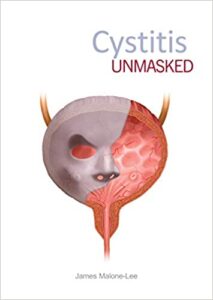 Cystitis Unmasked by James Malone-Lee
Cystitis Unmasked by James Malone-Lee
Publisher : TFM Publishing; 1st edition (March 15, 2021)
Paperback : 350 pages
ISBN-10 : 1910079634
ISBN-13 : 978-1910079638
A sample of glowing online reviews of Cystitis Unmasked suggest that this book is digestible by the lay public. In my opinion, it is not. Professor Malone-Lee has expressly written this book for clinicians, with the promise of an accessible message. I found the message obscured by the interesting tour from Ancient Greece to Egypt, from Shakespeare to Dickens, and from Darwin to Dawkins. What does Austen’s Emma Woodhouse really have to do with urinary tract infection?
The initial idea for the book was a series of chapters written by members of Malone-Lee’s research group. Apparently, it was decided that he should write the text and the others would check his spelling mistakes. I didn’t spot any spelling mistakes, but I felt that the author used some of the same pretentious language that he warns against. Cystitis Unmasked is one man’s story of a career dedicated to the study of urinary tract disease.
As a clinician, I wish to be presented with evidence from which I can draw my own conclusions. I don’t need an entire chapter dedicated to the possible reasons, from fallacies of prejudice to post-modernism, that explain why Malone-Lee’s treatment methods were rejected by commissioners. As a geriatrician, I am particularly interested in learning more about topics of clinical relevance, for example the author’s statement in chapter 5: ‘The systemic markers of inflammation, ESR and CRP, have no role in the assessment of UTI.’ I am drawn to the evidence, to find that the references for this section pertain only to children and so cannot be generalised to an adult population.
Malone-Lee does convey important messages to clinicians: individual patients do not necessarily behave like trial participants; don’t ignore blood and protein in the urine; remember the art of history and examination; beware of investigations; listen to the patient and remember the patient’s perspective. I am also reassured by his sensible approach to management of asymptomatic bacteriuria: ‘why would you treat if the patients have no symptoms?’
I found reading some of the text to be tiresome, so I welcomed the many illustrations. But I couldn’t fully interpret the graphs in chapter 7, because the ꭓ-axis detailed ‘assessment events’ rather than time. I feel that the reader deserves more information about the temporal relationship of these events and whether the scale is linear or non-linear.
Cystitis Unmasked highlights Malone-Lee’s passion and dedication to the subject and his patients. But is it his passion and patient-interactions which cure, or is it the prolonged antibiotic therapy? My understanding of the text is that this hasn’t been tested. Patient stories are hugely powerful and emotive, but they are not evidence of treatment efficacy. I felt the book lacked the suggested inclusion of ‘corroborative evidence from others around the world’. Or perhaps I was too distracted by the beautiful illustrations of orchids, or too busy looking up flowery vocabulary in the dictionary?
For the second edition of Cystitis Unmasked, I would like to see a truly collaborative text and the presentation of high-quality trial evidence of his treatment regimes, so that people everywhere living with disabling urinary tract symptoms can receive safe, effective and person-centred care.
Clare Bostock, MJA Member
For further information/review copies contact:
Matt De Bono, Digital Sales
T: +44(0)20 8882 6023
M: +44(0)7980 195452
E:


Recent Comments